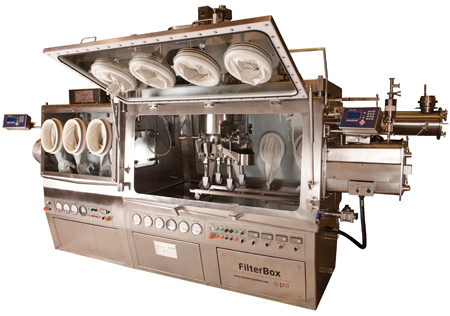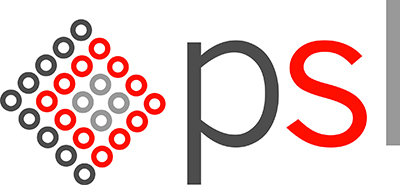Today drug discoveries are leading to more effective potent drugs, which also require greater worker protection. Powder Systems Ltd (PSL) supported Helsinn Advanced Synthesis set up such a facility for producing cytotoxics.
Helsinn Advanced Synthesis (HAS), located in Biasca, Switzerland, is the chemical manufacturing business unit of the Helsinn Group. To meet the demand for anticancer molecules HAS opened a new cytotoxic facility this year. The plant comprises R&D and QC laboratories, a small-scale GMP area for the production of reduced quantities of cytotoxic active pharmaceutical ingredients (APIs) and two larger production areas for the production of cytotoxic product at commercial scale.
The facility is exclusively dedicated to the development, analysis and manufacturing of clinical and commercial cytotoxic APIs. It has a 3b category with an Occupational Exposure Level (OEL) of less than 50ng/m3 for the protection of the operator, environment and product when handling cytotoxic compounds (see Figure 1).
The Laboratory: The new dedicated laboratory has been constructed for R&D trials, initial process development and QC analysis. Some of the most important equipment has been custom designed to meet Helsinn’s requirements and needs.
cGMP Production: The cytotoxic plant is segmented into three production levels: Each area is designed using state-of-the-art ‘closed system’ equipment with variable air pressure and engineering controls.
In terms of manufacturing capability, HAS can offer three levels of production dedicated to cytotoxic compounds:
Pilot Scale Production Centre
- Reactor Configuration: 20L Hastelloy and 30L Glass Reactors
- Product Isolation: 10L Tray Dryer and 30L Nutsche Filter
Small Scale Commercial Production Centre
- Reactor Configuration: 250L Glass, 250L Hastelloy and 400L Hastelloy
- Product Isolation: 0.125m2 Hastelloy Pressure Filter Dryer (FilterBox)
Large Scale Commercial Production Centre
- Reactor Configuration: 630L Glass, 630L Hastelloy and 800L Hastelloy
- Product Isolation: 0.3m2 Hastelloy Pressure Filter Dryer (FilterBox)
Production Centres are multipurpose facilities designed to process one product at a time. The facilities’ specific design criteria included the capability to operate at a temperature range from –80°C up to +150°C and pressure range up to 8 Bar. They have a specific design and equipment to meet stringent OEL – down to 50ng/m3. They have additional safety measures for superior health and safety protection and employ an enclosed system from raw material to finished product.
PSL worked closely with HAS to develop suitable solutions for the cytotoxics plant and supplied a suite of high containment systems, including contained Hastelloy pressure filter dryers, charging glove boxes with slurry vessels and complete clinical trial production facilities.
As a pioneer of containment, PSL has a wealth of experience designing and engineering advanced containment processes for highly potent and valuable products. HAS asked PSL to partner it in designing solutions that would meet the strict manufacturing requirements necessary for cytotoxic processes.
Good communication between PSL and Helsinn management meant that ergonometric performances and fine-tuning of the containment equipment were rapidly achieved and the most creative and innovative ideas came through long and positive conversations between the project managers of the respective companies.
From drawings and discussions on user requirements, a budget cost and definition was first formed. Numerous technical aspects needed to be considered and discussed at this stage between the PSL sales engineering team and HAS process and project teams. This was followed by 3-D modelling and then a front-end design study to review in detail the following process integration and ergonomic features:
- The glove box isolator designs had to be workable by the operator. Some operations were mocked-up using full-scale models to assess ergonomics (see Figure 2)
- For easier operation oval glove ports were incorporated with a maximum of 550mm (front to back) for single-sided ridged window access or via a double-sided glove box
- Direct access to the room where the machines would be installed was necessary to undertake accurate site measurements and full integration of all process equipment where necessary.

Figure 2: Full scale mock-up of a clinical trial isolator
All this provided an opportunity for additional discussions and agreements, and then a full documentation package was supplied for review prior to commencing final manufacture. PSL project management had regular updates with HAS on manufacturing progress up to the Factory Acceptance Tests (FAT) at its Liverpool facility (UK), representing the final stage before delivery and installation at the cytotoxic plant in Biasca, Switzerland.
Last year saw the installation first of a clinical trial isolator within the small scale GMP area for the production of reduced quantities of cytotoxic APIs for clinical and registration purpose. HAS required complete synthesis facilities performing reaction, filtration and drying within a single enclosed environment. PSL’s solution was to perform all the pilot scale operations inside one single isolator performing the processes in a completely contained environment.
HAS required complete synthesis facilities performing reaction, filtration and drying within a single enclosed environment
This clinical trial isolator consists of several in-line synthesis processes, including reaction or hydrogenation within a glass reactor of 20L, Buchner filtration and drying within PSL’s CakeStand Tray Dryer. This vacuum tray dryer overcomes the inherent difficulties with traditional vacuum drying ovens: through its direct tray heating, the CakeStand performs proven heat uniformity up to a maximum temperature variation of +/-1°C. The tray dryer integrated within the clinical trial isolator has four heated shelves, a pivot door and is contained in the isolator ensuring high containment during transfer of the cytotoxic compounds.
The full synthesis containment system has HMI/PLC control, washing and clean-in-place (CIP) capabilities with a proven OEL of less than 50ng/m3 in 8 hours (hrs) TWA up to 2.6ng/m3 in 8hrs TWA on certain test runs, carried out on-site and approved by a third party industrial hygienist.
Production scale areas
For kilo-lab and pilot scale production, PSL also supplied two charging isolators and contained filtration, drying and milling suite. The two isolators, called SlurryBox, offer dispensing, weighing, charging of slurry vessels and bag filtration. This system allows Helsinn to have two central charging stations supplying several reactors.
To do so, first the high potent powder is brought into the SlurryBox through RTP or in bag airlock and is dispensed and weighed with a PSL weigh scale specially designed for highly potent compounds. Then the powder is charged into PSL’s Slurry Vessel fitted with nozzles to charge liquid. If required the pressured vessel can be heated and agitated to improve dissolution. The slurry is then transferred under pressure into reactors; this allows better control of the charging flow without using valves, which could be more complex to clean.
This process also allows the operator to move highly potent slurry instead of powder within the plant, greatly reducing the risk of airborne contamination. The Slurry Vessels are built for highly potent compounds with a CIP spray ring to clean each nozzle and minimum product retention design.
The catalysts and carbons coming from the filter dryer process cannot be readily discarded as they have been in contact with highly potent APIs
These two isolators include bag filters for catalysts recovery and carbon filtration. It is necessary for a cytotoxic plant to recover these in a contained manner. The catalysts and carbons coming from the filter dryer process cannot be readily discarded as they have been in contact with highly potent APIs and therefore need to be recovered in a contained manner. This can be performed within the SlurryBox and once recovered the operator can unload the filter in a continuous liner.
Finally, the contained filtration, drying and milling suite consists of two Hastelloy Pressure Filter Dryers fully integrated within PSL high containment isolators, called FilterBox (see Figure 3).

Figure 3: PSL FilterBox-contained pressure filter dryer
The FilterBox technology is the optimum contained filtration and drying solution for handling cytotoxic compounds. It allows the following operations to be performed in a completely contained environment:
- Filtration and drying with PSL’s Filter Dryer
- Contained sampling
- Filter mesh inspection and swapping >li>Safe and contained base opening and washing
- Inline milling with Comil
- Discharging, dispensing and packing
The filter dryers installed in Biasca have a filtration area of 0.125m2 and 0.3m2 for scale-up of production. PSL’s Filter Dryer is the only ANFD designed for handling potent and cytotoxic products and has numerous features for high performance – a minimum volume clamp base design, tapered filter plate for optimum seal, full heating jacket to maximise heat transfer, a one piece agitator equipped with omega wave bellows, etc.
Due to the characteristics of the products, it was necessary to be able to open the base completely and manually clean some critical areas in a contained manner. With the FilterBox, the cleaning procedure can be performed safely and thoroughly as the complete vessel base, filtration media and discharge plug can be accessed in a contained environment.
The production facilities had the same category 3b as the small scale GMP area, and the OEL limit for both SlurryBoxes and FilterBoxes is less than 50ng/m3 in 8hrs TWA.
PSL carried out the installation and necessary qualifications (IQ/OQ) at Helsinn’s Biasca facility. This included delivery of the full documentation package and operator training on-site. PSL engineers have worked closely with Helsinn to get the entire containment systems installed and ready for production this year.
The resulting state-of-the-art cytotoxic plant showcases the latest technologies available on the market for advanced production of highly potent compounds and is an example of successful project implementation and management from both Helsinn and its suppliers.

